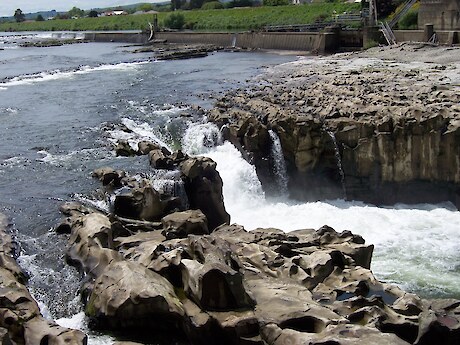The importance of rivers
 Mataura RiverThe Rivers – as landing places – from sea journeys
Mataura RiverThe Rivers – as landing places – from sea journeys
- as borders
- as food sources
- as routes between the inland resources and coastal resources
- as routes between the coastal and inland living spaces
- as routes for trade, marriage and war
- the events and connections enabled within the iwi by these rivers
Tributaries
- as borders
- as food sources
- as parts of routes between the inland resources and coastal resources as parts of routes for trade, marriage and war
- as parts of living spaces connected by the rivers
Connections between the rivers
- in the names
- Karoro/Tuturau whakapapa connections
- Karoro/Tuturau mahika kai connections
- The Lakes – connecting trails between the rivers and their sources The Beaumont Crossing and related trails
- The Moa Flat Trail connection
Connections between the eras
- The eras of creation and the beginning of whakapapa
- The eras of exploration – Rakaihautu and Rapuai, Waitaha and Kati Mamoe, Kati Mamoe and Kai Tahu
- Moas and moa hunting
- Stone resources
- Mahika kai after moas
Find out about the Mataura (Mata Ura) and Clutha (Mata Au) rivers and important place names.
Wai and Whakapapa - their importance and their relationship from the Māori perspective
Te wai puataata e rere nei i nga awaawa, ehara i te wai noa iho ki a matou.
Heoi e rite ana ki te toto o nga tupuna matua.
Nga tihi o nga maunga, nga piko o nga awa, nga kumore o te wahapu,
Nga mania, nga raorao,
He taumata whakairinga korero enei o nga wheinga.
Hei matua kia matou,nga awa e na ai te wheinu,
E tari i nga waka, e whangai i nga mokopuna[1].
Wai from the beginning
The following account from the creation of the world and Tane’s role with regard to water and its various forms comes from White’s Ancient History of the Māori and is attributed to a Kai Tahu source.
Te Moana
Ka tahi ano kaa (nga) tupu te wai. Ko Te Au-wiwhi (whiwhi), ko Te Au-wawae, ko Te Au-puha, ko Te Au-mahora, ko Te Au-titi, ko Te Au-kokomo, ko Te-au-huri, ko Te Au-take, ko Te Au-ka-kawha (ngawha) ka mate, ka tika ano te au, ko Te Au- komiro, ko Te Au-puha, ko ka (nga) Potiki, Titi-te-au, Tata-te-au, Maro-te-au, Whaka-hotu-te-au, ki Hawaiki, ko To, ko Tapa, ko nga Rimu, ko Te-takapu, ko Hine- i-ahua, ko Hine-i-te-rakatai (rangatai), ko Te-kare-nuku, ko Te-kare-raki, ko Hotu- atea, ko Te-wiwini, ko Te-wana, ko Te-pa, ko Te-kare-tuatahi, ko Te-kare-tuarua, ko Te-kare-tuatoru, ko Te-kare-tuawha, ko Te-kare-tuarima, ko Te-kare-tuaono, ko Te- kare-tuawhitu, ko Te-kare-tuawaru, ko Te-kare-tuaiwa, ko Te-kare-tuakahuru (ngahuru), ko Tarawa-tuatahi, ko Tarawa-tuarua, ko Tarawa-tuatoru, ko Tarawa- tuawha, ko Tarawa-tuarima, ko Tarawa-tuaono, ko Tarawa-tuawhitu, ko Tarawa- tuawaru, ko Tarawa-tuaiwa, ko Tarawa-tuakahuru (ngahuru), ko Te-Hiwi, ko Te- Amo, ko Te-Riaki, ko Te Hapai, ko Te-Tike-tike, ko Te-Rairahi (Rahirahi), ko Te- Kapuka, ko Te-whatika (whatinga), ko Te-Horoka (horonga), Ko Te-whakahuka, ko Whati-tata, ko Puke-maho-ata, ko Te-Rimu, Ko Mai-ra-uta, ko Te-Takapau, ko Te- whatu-moana, ko Te-Tira, ko Moana-nui Tane, ko Ao-nui te huanga mai, me te uptake o nga Pai-ao.
Na Tane te moana i horahora, a nana ano hoki i horahora te rangi.
Tane-nui-o-Raki, no te hapu atua aia, a he teina no Rehua, ko Raki tem atua tane. Ko Watu (Whatu)-papa te hakui.
Translations of terms (Whites):
- Te-au-whiwhi: the entangled current (platted or woven?)
- Te-au-wawae: the separating current
- Te-au-puha: the blurting current
- Te-au-mahora: the expanded current
- Te-au-titi: the piercing current
- Te-au-kokomo : the entering current
- Te-au-huri: the turning current
- Te-au-take: the original current
- Te-au-ka-kawha (ngawha): the split current.
- Te-au-komiro: the entwined current
- Te-au-puha: the spurting current
- Ka(nga)-pikiki (pokihikihi): the spluttering (current?)
- Titi-te-au: pirecing current
- Tata-te-au: the dashing current
- Maro-te-au: unimpeded current
- Whatu-hotu-te-au-ki-hawaiki: sobbing current to Hawaiki
- To: drag
- Tapa: the brim
- Nga Rimu: mosses or seaweeds
- Te-taka-pau: the sanctity departed
- Hine-i-ahua: the daughter formed
- Hine-i-te-raka(ranga)-tai: daughter of the seas shore company?
- Te-kare-nuku: the beloved of earth
- Te-kari-raki: the beloved of sky
- Hotu-a tea: sob of daydawn
- Te-wiwini: the trembling
- Te-wana: the bud
- Te-pa: the obstruction?
- Te-kare-tua-tahi: the first ripple
- Te-kare-tua-rua: the second ripple
- Te-kare-tua-toru: the third ripple
- Te-kare-tua-wha: the fourth ripple
- Te-kare-tua-rima: the fifth ripple
- Te-kare-tua-ono: the sixth ripple
- Te-kare-tua-whitu: the seventh ripple
- Te-kare-tua-waru: the eight ripple
- Te-kare-tua-iwa: the ninth ripple
- Te-kare-tua-kahuru (ngahuru): the tenth ripple
- Te-tarawa-tua-tahi: suspended first
- Te-tarawa-tua-rua: suspended second
- Tarawa-tua-toru: suspended third
- Tarawa-tua-wha : suspended fourth
- Tarawa-tua-rima: suspended fifth
- Tarawa-tua-ono: suspended sixth
- Tarawa-tua-whitu: suspended seventh
- Tarawa-tua-waru: suspended eight
- Tarawa-tua-iwa: suspended ninth
- Tarawa-tua-kahuru (ngahuru): suspended tenth
- Hiwi: hilltop
- Amo: carry on a litter
- Riaki: lift up
- Hapai: carry in hand
- Tiketike: very lofty
- Te Rairahi (Rahirahi): thin
- Kapuka (Kapunga): palm of the hand
- Te-wha-tika: stand up
- Te-horoka (Horonga): the swiftness
- Te-whaka-huka: becoming frothy
- Whati-tata: breaking close to
- Puke-maho-ata: vessel floating at dawn of day
- Te Rimu: moss or seaweed
- Maira-uta: coming overland
- Takapau: sanctity departed
- Te-whatu-moana: eye of the ocean
- Moana-nui: great sea
[1] He Kura Taonga a Papatuanuku; a translation into Maori o the address said to be from Chief Seattle to European land buyers in the NW USA; by Shane Jones, 1988.
